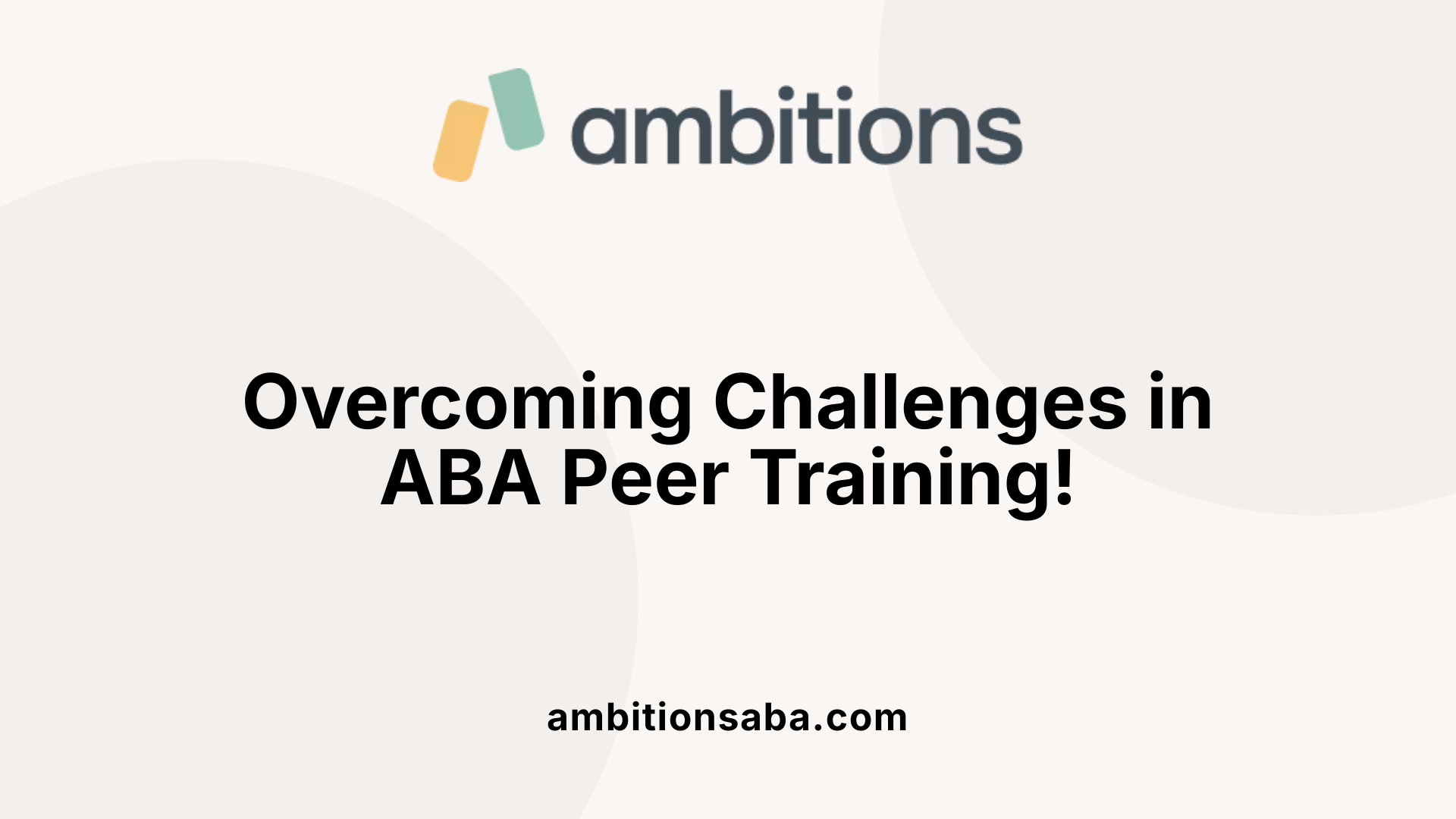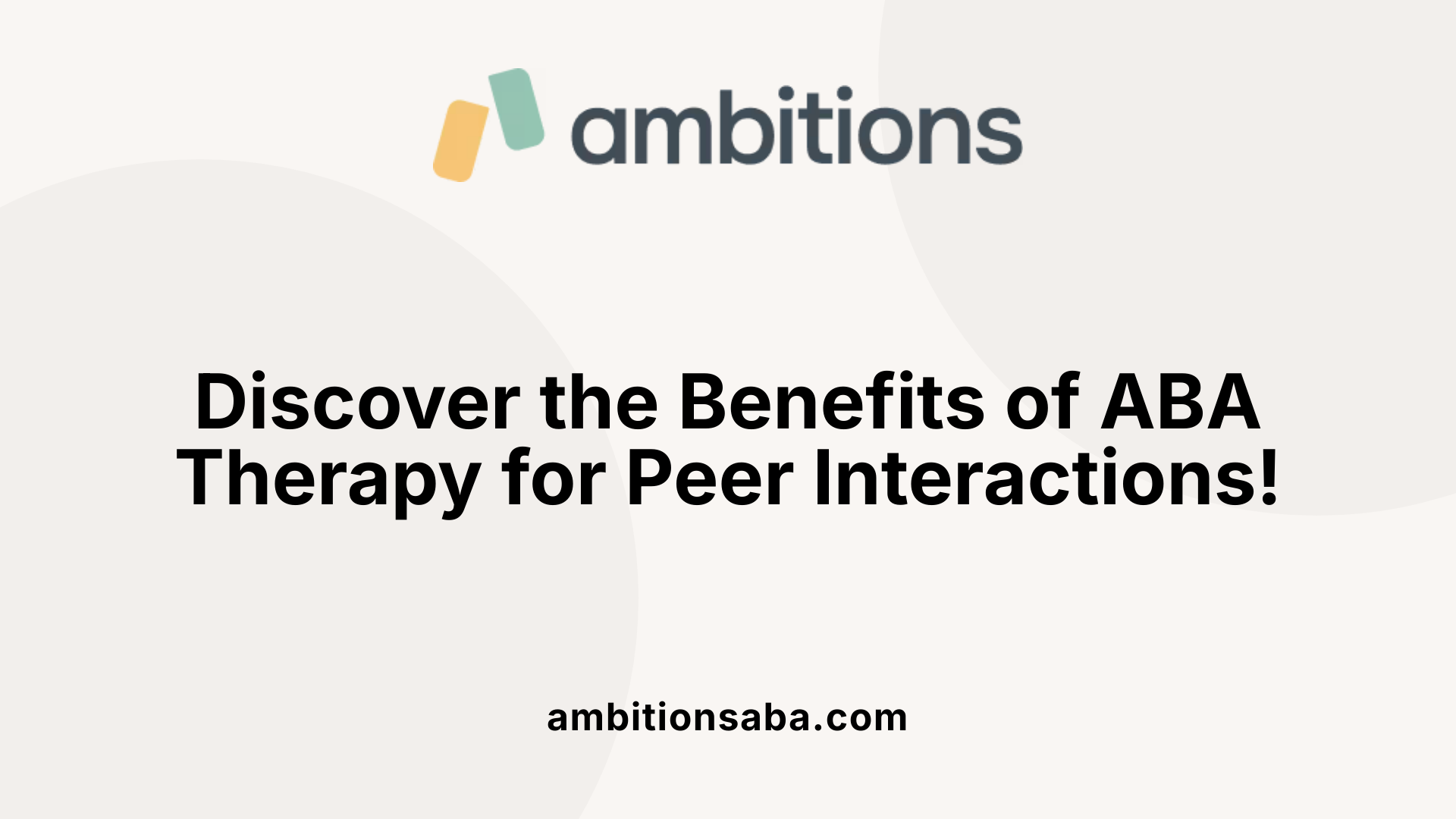Empowering Parents Through Structured ABA Strategies
Understanding ABA Therapy for Social Connection
Applied Behavior Analysis (ABA) therapy has long-supported individuals with autism in developing life skills, particularly in social realms. By breaking down complex social behaviors into manageable components, ABA offers targeted strategies to enhance peer interactions among children with autism. This structured approach not only aids in building communication skills but also fosters an environment where inclusivity and lasting friendships can thrive. Exploring how ABA can enhance social interactions reveals a tapestry of methods and insights beneficial to parents, educators, and therapists alike.
Key ABA Techniques for Social Skill Development

What are effective ABA techniques to improve social interactions among children with autism?
Effective ABA techniques for improving social interactions among children with autism encompass a variety of methods, focusing on the individual needs of each child. Here’s a closer look at key strategies:
Modeling in ABA
- Therapists demonstrate appropriate social behaviors for children to observe and imitate.
- This helps children understand turn-taking, initiating conversations, and responding correctly to social cues.
Positive Reinforcement Strategies
- Immediate praise or rewards reinforce desired social behaviors.
- For example, if a child shares a toy, they might receive verbal encouragement or a small reward, enhancing their willingness to repeat the behavior.
Role-Playing and Social Stories
- Role-playing scenarios provide a safe environment to practice social interactions.
- Social stories present common social situations in a narrative format, helping children anticipate and navigate peer interactions effectively.
Individualized Interventions
- Tailored treatment plans assess specific social deficits in each child, providing targeted strategies.
- For instance, while some may need help with initiating conversations, others may require support to recognize nonverbal cues.
Through these techniques, children can gradually build confidence and competence in their social interactions, paving the way for meaningful relationships with their peers.
Creating Inclusive Group Settings with ABA

How can ABA therapy facilitate peer interactions and inclusion in group settings for children with autism?
ABA therapy plays a vital role in creating inclusive group settings for children with autism by systematically teaching social skills through structured activities. These activities often incorporate positive reinforcement, which encourages children to engage in desired behaviors, such as sharing and turn-taking during play.
Role-Playing in Group Settings
Role-playing is a fundamental technique in ABA therapy. By simulating social scenarios, children can practice greetings, following conversational norms, and cooperative play. This hands-on approach helps them internalize social cues and develop the confidence to apply these skills during real interactions with peers.
Task Analysis in Peer Interactions
Task analysis breaks down complex social behaviors into smaller, manageable steps. For example, during group activities, therapists guide children through the process of joining in play, reinforcing their efforts as they learn how to initiate interactions and respond appropriately to peers.
Visual Supports for Anxiety Reduction
Visual supports, such as schedules and social stories, provide predictability, which is crucial for children with autism. These tools help reduce anxiety by offering clear expectations for group activities, making it easier for children to understand what to expect and how to participate.
Enhancing Sense of Community
Creating a sense of community involves fostering connections between children with autism and their neurotypical peers. Peer training, where neurotypical children are prepared to engage empathetically with their peers, is particularly effective. This not only promotes acceptance but also builds lasting friendships, enhancing the social environment for all participants.
By implementing these strategies, ABA therapy effectively promotes inclusive environments that encourage social interactions, acceptance, and a sense of belonging for children with autism.
Addressing Challenges in ABA Peer Training

What challenges exist in peer training within ABA therapy, and how can they be effectively addressed?
Peer training in ABA therapy faces several challenges that can impact its effectiveness. One significant challenge is the varying levels of understanding and social skills among peers. This discrepancy can hinder effective collaboration and prevent mutual learning. For example, a child with advanced social skills may struggle to connect with a peer who finds it difficult to engage due to lower social competencies.
Another challenge stems from the highly personalized nature of ABA interventions. Each child’s needs and strengths vary, making it tough to implement a standardized peer training model. Tailoring approaches for each child is crucial but can lead to logistical complications.
To address these challenges, several strategies can be employed:
- Clear instructions and consistent feedback: Providing detailed guidelines for interactions can help neurotypical peers understand their roles better and enhance the learning experience for children with autism. Regular feedback ensures that all participants can improve their techniques and understanding.
- Family involvement: Engaging family members is vital. Involving caregivers can support skill generalization and create a continuity of practice in home contexts.
- Education for caregivers: Empowering family members with knowledge about the peer training process fosters a supportive environment. Parents who understand the objectives and methodologies are better equipped to reinforce skills at home.
- Therapist caseload management: Keeping therapist caseloads manageable is essential to ensure they can provide quality attention to peer training interactions. A lower caseload allows therapists to focus on the nuanced needs of both children with autism and their neurotypical peers, enhancing outcomes.
By implementing these strategies, the challenges of peer training in ABA therapy can be effectively alleviated, leading to improved social skills development and successful peer interactions.
The Benefits of ABA in Enhancing Peer Interactions

What are the benefits of ABA therapy for enhancing peer interactions among children with autism?
ABA therapy provides a variety of advantages that focus on improving the social interactions of children with autism. Here’s a brief overview of its benefits:
Skill development in social cues
- Children learn to recognize social signals, body language, and tone of voice, essential for navigating peer relationships.
- Through techniques like role-playing and social stories, children practice these cues in a supportive setting.
Safe practice environments
- Structured settings, such as group activities, allow for the practice of social skills without the anxiety often associated with unstructured and intimidating social situations.
- Reinforcement methods encourage desired behaviors, like sharing and turn-taking, in a relaxed environment.
Empathy and conversation skills
- Techniques such as modeling interactions help children learn the importance of understanding their peers’ perspectives, thereby fostering empathy.
- Regular practice with both neurotypical and ASD peers provides chances to initiate and maintain conversations, boosting overall communication skills.
In conclusion, ABA therapy equips children with the tools to develop effective communication, enhances their ability to interact socially, and promotes inclusive environments that support enduring friendships and social confidence.
Implementing Peer Training to Support Social Integration
Role of Peer Models in ABA
Peer models play a crucial role in ABA therapy by providing children with autism the opportunity to learn social skills through engagement with neurotypical peers. These models are trained to initiate and maintain social interactions, fostering an inclusive atmosphere for children who may otherwise struggle in social settings. By observing and imitating their peers, kids with autism can better understand social norms, such as taking turns and responding to verbal cues.
Supervised Interaction with Neurotypical Peers
In structured peer training sessions, therapists closely supervise interactions between children with autism and their neurotypical counterparts. This supervision ensures that the exchanges are positive and effective by providing immediate feedback when necessary. Initially, these guided sessions allow children to practice new skills in a supportive environment, building their confidence and social competence over time.
Natural Learning Environments for Skill Application
Peer training is often conducted in natural learning environments, such as playgrounds or classrooms, where the skills learned can be directly applied to real-life situations. This approach increases relevancy and promotes generalization of social skills beyond structured therapy. Moreover, using motivating activities tailored to children's interests significantly enhances engagement and interaction, making the learning process enjoyable and effective.
Promoting Inclusive Practices Through Education and Empathy
Educating Peers About Autism
Education plays a crucial role in fostering understanding and acceptance of autism among students. Implementing classroom presentations, inviting guest speakers, and using relatable materials about autism can effectively demystify it. Involving children in role-playing activities can also help them understand the experiences of their peers with autism, thereby enhancing empathy.
Role-Playing and Empathy-Building
Role-playing serves as a powerful tool for building empathy. It allows neurotypical peers to step into the shoes of their classmates with autism, encouraging them to appreciate different perspectives. Activities that simulate social situations help children practice patience and understanding, essential traits for nurturing supportive relationships.
Addressing Bullying and Stigma
Proactive measures to tackle bullying and stigma surrounding autism are imperative. Schools should adopt anti-bullying policies, promote awareness campaigns, and encourage students to advocate for their classmates. By creating an environment that prioritizes acceptance and inclusion, schools can significantly enhance social interactions for children with autism, leading to improved outcomes and social integration.
Harnessing Interests to Foster Friendships

Connecting through shared interests
One effective strategy for helping children with autism form friendships involves tapping into their unique interests. When children engage in topics they are passionate about—be it dinosaurs, video games, or animals—they find common ground with peers. For instance, a child fascinated by dinosaurs can initiate conversations around this subject, inviting others to share their thoughts or participate in related activities. This shared enthusiasm fosters a sense of belonging and can lead to deeper connections.
Role of motivation in social interactions
Motivation plays a crucial role in social interactions among children with autism. Sharing activities that align with a child's interests increases the chance of engagement. When children are genuinely excited about an activity, they are more likely to interact naturally with their peers. This intrinsic motivation encourages them to practice social skills like turn-taking and responding to social cues—essential elements in building friendships.
Creating supportive environments
Structured environments that promote inclusion are vital for nurturing relationships. Peer buddy programs and cooperative play activities create opportunities for meaningful interactions. Therapists can facilitate these settings, ensuring they are engaging and provide ample chances for children to practice social skills. By modeling desired interactions and providing encouragement, children with autism can build their self-esteem and feel valued within their community, leading to long-lasting friendships.
Harnessing ABA for Lasting Social Impact
The journey of fostering peer interaction among children with autism through ABA therapy is a multi-faceted one, grounded in understanding, empathy, and structured methodology. Utilizing techniques like positive reinforcement, role-playing, and peer interaction not only builds essential social skills but also paves the way for meaningful friendships and community inclusion. As both parents and therapists collaborate in implementing these strategies, the potential for children with autism to thrive socially becomes increasingly profound. By nurturing their unique interests and creating inclusive settings, ABA therapy helps light the way toward a more understanding and connected world, ensuring every child has the opportunity to engage and grow in their social environments.
References
- Peer Play: Facilitating Positive Social Interactions for Autism
- Social Skills Development Through Peer Interaction for Kids with ...
- ABA Therapy for Improving Social Skills | Level Ahead
- Autism to Peers: Educating Friends and Classmates | ABA Therapy
- Fostering Friendships in Kids with Autism | ABA Therapy Near Me
- ABA Therapy: Enhancing Social Skills for Autistic Children
- Peer Training Can Help Children With Autism Spectrum Disorder
- 3 Tips for Facilitating Peer Interactions - London - The Children's Place

